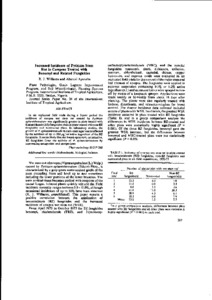| dc.contributor.author | Williams, R.J. |
| dc.contributor.author | Ayanaba, A. |
| dc.date.accessioned | 2019-12-04T11:08:11Z |
| dc.date.available | 2019-12-04T11:08:11Z |
| dc.date.issued | 1975 |
| dc.identifier.citation | Williams, R. J. & Ayanaba, A. (1975). Increased incidence of Pythium stem rot incowpeas treated with benomyl and related fungicides. Phytopathology, (65), 217-218. |
| dc.identifier.issn | 0031-949X |
| dc.identifier.uri | https://hdl.handle.net/20.500.12478/1753 |
| dc.description.abstract | In six replicated field trials during a 3-year period the incidence of cowpea wet stem rot caused by Pythium aphanidermatum was significantly greater in plots treated with benzimidazole (BZ) fungicides than in plots treated with non-BZ fungicides and nontreated plots. In laboratory studies, the growth of P. aphanidermatum in corn-meal agar was unaffected by the addition of up to 250 µg/ml active ingredient of the BZ fungicides. It seems likely that the broad-spectrum, yet selective, BZ fungicides favor the activity of P. aphanidermatum by suppressing antagonists and competitors. |
| dc.format.extent | 217-218 |
| dc.language.iso | en |
| dc.subject | Stems |
| dc.subject | Cowpeas |
| dc.subject | Fungicides |
| dc.subject | Thiabendazole |
| dc.subject | Biological Control |
| dc.title | Increased incidence of Pythium stem rot in cowpea treated with benomyl and related fungicides |
| dc.type | Journal Article |
| dc.description.version | Peer Review |
| cg.contributor.affiliation | International Institute of Tropical Agriculture |
| cg.coverage.region | Africa |
| cg.coverage.region | West Africa |
| cg.coverage.country | Nigeria |
| cg.isijournal | ISI Journal |
| cg.authorship.types | CGIAR single centre |
| cg.iitasubject | Cowpea |
| cg.iitasubject | Grain Legumes |
| cg.iitasubject | Plant Diseases |
| cg.journal | Phytopathology |
| cg.howpublished | Formally Published |
| cg.accessibilitystatus | Limited Access |
| local.dspaceid | 83079 |
| cg.targetaudience | Scientists |
| cg.identifier.doi | https://dx.doi.org/10.1094/phyto-65-217 |

